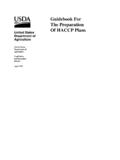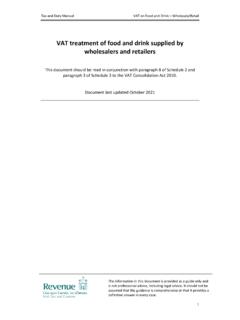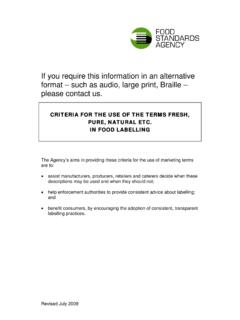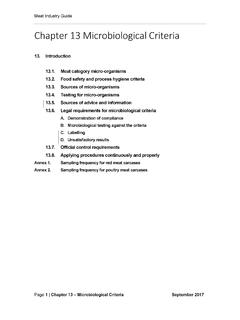Transcription of Generic HACCP* Model for Poultry Slaughter
1 Generic HACCP* Model for PoultrySlaughter*Hazard Analysisand Critical ControlPoint ( haccp )United StatesDepartmentof AgricultureFood Safetyand InspectionServiceMarch 1994 IntroductionHACCP Generic Model for Poultry SlaughterHazard Analysis and Critical Control Points ( haccp ) is a system of processcontrol. It is designed to prevent the occurrence of problems by ensuring thatcontrols are applied at any point in a food production system where hazardous orcritical situations could occur. Hazards could include microbiological, chemical, orphysical adulteration of food late May 1993, Department of Agriculture (USDA) Secretary Mike Espydirected USDA's Food Safety and Inspection Service (FSIS) to provide him with aplan for implementing mandatory haccp in the nation's meat and poultryestablishments. The Secretary recognized that such a system, which has been understudy by FSIS, was a necessary building block of the inspection system of the workshops held in 1991 and 1992, five Generic haccp models were developedand are being published for public information.
2 The models should be useful forcompanies developing individualized five Generic haccp models are: Refrigerated Foods Cooked Sausage Poultry Slaughter fresh Ground Beef Swine SlaughterThe workshop for Poultry Slaughter was held in Atlanta, Georgia, from August 27-29, 1991. Over 40 technical and subject matter experts from industry andgovernment collaborated in the Generic Model development. Participants identified10 critical control points (CCP's) for Poultry Slaughter , including: receiving, scalding,venting/opening/eviscerating, off-line procedures, neck and giblet chilling, final wash,carcass chilling, packaging/labeling, and storage/distribution. This is the genericHACCP Model for Poultry on the other four workshops follows:The workshop for fresh Ground Beef was held in Phoenix, Arizona, from December3-5, 1991. Over 40 technical and subject matter experts from industry andgovernment collaborated in the Generic Model development.
3 Participants identified10 critical control points(CCP s) for fresh ground beef, including: Sanitation,receiving, storage, assembly/pre-weigh/pre-grind (re-work), final grind,packaging/labeling, storage, and shipping. This is the Generic haccp Model forFresh Ground workshop for Pork Slaughter (Market Hogs) was held in Minneapolis,Minnesota, from March 31-April 2, 1992. Over 40 technical and subject matterexperts from industry and government collaborated in the Generic modeldevelopment. Participants identified 10 critical control points (CCP s) for porkslaughter, including: receiving/holding, scalding, dehairing, trimming, neckbreaker/head dropping/brisket opening, splitting, trim rail/final rail inspection fortrimming, cooler, operational sanitation, and pre-op sanitation. This is the genericHACCP Model for Pork Slaughter (Market Hogs).The workshop for Cooked Sausage was held in Fort Worth, Texas, from May 21-23,1991.
4 Over 40 technical and subject matter experts from industry and governmentcollaborated in the Generic Model development. Participants identified 9 criticalcontrol points (CCP s) for cooked sausage, including: receiving, meat preparation,non-meat ingredient compounding, pre-blend/formulation/staging (re-work),cooking/smoking, chilling/storage, peeling, packaging, and storage. This is thegeneric haccp Model for Cooked workshop for Refrigerated Foods was held in Baltimore, Maryland, formFebruary 26-28, 1991. Over 40 technical and subject matter experts from industryand government collaborated in the Generic Model development. Participantsidentified 12 critical control points (CCP s) for refrigerated foods, including:preparation, cooking, chilling, assembling components into packages, flushing withgas atmosphere, package inspection, labeling and code dating, chilling, and storage,This is the Generic haccp Model for Refrigerated CATEGORY DESCRIPTIONPRODUCT CATEGORY:READY TO COOK WHOLE YOUNG CHICKENWORKSHOP LOCATIONATLANTA, GATHE FOLLOWING QUESTIONS NEED TO BE ANSWERED WHEN DEVELOPING THEPRODUCT CATEGORY NAME?
5 READY TO COOK WHOLE IS IT TO BE USED?FOR HUMAN CONSUMPTION OF PACKAGE?BAG, BOXED AND OF SHELF LIFE, ATWHAT TEMPERATURE?VARIES WITH METHOD OFPACKAGING AND TEMPERATUREOF WILL IT BE SOLD?RETAIL, WHOLESALE AND INSTRUCTIONS?KEEP REFRIGERATED OR FROZEN;COOK PRIOR TO SPECIAL DISTRIBUTIONCONTROL NEEDED?VARIES WITH METHOD OFPACKAGING AND TEMPERATUREOF STORAGEDESCRIPTIONNOTE:THIS IS A DOCUMENT DEVELOPED AT THE INDUSTRY haccp WORKSHOP FOR YOUNG CHICKEN Slaughter IN ATLANTA, GA. ITDEMONSTRATES THE METHODOLOGY USED TO DEVELOP THE Generic INDUSTRY haccp 29, 1991 NECK CUTTERCARCASS CHILLING 8M, PSORT/GRADE/HANGPACKAGING/LABELING 9 M, PRECEIVING 2M, C, PKILLINGBLEEDINGSINGEINGHEAD REMOVALTRANSFER/REHANGOIL SAC CUTTERINSPECTIONHELPERLIVER & HEART HARVESTSTUNNINGHANGINGPICKINGSCALDING 3 MWASHINGHOCK CUTTERWHOLE YOUNG CHICKENVENTING/OPENING/EVICERATING 4 MPRESENTINGOFFLINE PROCEDURE 5 MNECK & GIBLET CHILLER 6M, PGUT CUTTERGIZZARD HARVESTCROPPINGNECK BREAKINGLUNG REMOVALTRIMMERHOUSE CHECKERFINAL WASHER 7 MCONDEMNDISPOSITIONSTORAGE/DISTRIBUTION 10 MNOTE: CCP 1M/SANITATIONM = MICROBIOLOGICAL HAZARDC = CHEMICAL HAZARDP = PHYSICAL HAZARDNOTE: THIS IS A DOCUMENT DEVELOPED AT THE INDUSTRY HACCPWORKSHOP FOR YOUNG CHICKEN Slaughter IN ATLANTA, GA.
6 ITDEMONSTRATES THE METHODOLOGY USED TO DEVELOP THE GENERICINDUSTRY haccp haccp WORKSHOPFINISHED PRODUCT/INGREDIENT HAZARDPRODUCT CATEGORY:READY TO COOK WHOLE YOUNG CHICKENWORKSHOP LOCATIONATLANTA, GATHE FOLLOWING QUESTIONS NEED TO BE ANSWERED WHEN DEVELOPING THEPRODUCT CATEGORY NAME?READY TO COOK WHOLE IS IT TO BE USED?FOR HUMAN CONSUMPTION OF PACKAGE?BAG, BOXED AND OF SHELF LIFE, ATWHAT TEMPERATURE?VARIES WITH METHOD OFPACKAGING AND TEMPERATUREOF WILL IT BE SOLD?RETAIL, WHOLESALE AND INSTRUCTIONS?KEEP REFRIGERATED OR FROZEN;COOK PRIOR TO SPECIAL DISTRIBUTIONCONTROL NEEDED?VARIES WITH METHOD OFPACKAGING AND TEMPERATUREOF STORAGEINDUSTRY haccp WORKSHOPFINISHED PRODUCT/INGREDIENT HAZARD ANALYSIS/RISK ASSIGNMENTPRODUCT CATEGORY : READY TO COOK WHOLE YOUNG CHICKENSWORKSHOP LOCATION : ATLANTA, GAPRODUCT HAZARD.
7 CHEMICALHAZARD CHARACTERISTICS ASSOCIATEDWITH THE FINISHED PRODUCT AND + = A HAZARD EXISTS 0 = NO HAZARD EXISTSABCDEF(1) FINISHED PRODUCT (RTC WHOLEYOUNG CHICKENS)*0000+I(2) INGREDIENTLIVE YOUNG CHICKENS*0000+I*HAZARD CHARACTERISTIC A N/A for industry Generic workshop haccp doing Finished Product hazard analysis risk assignment, consider all ingredients and processesused in the establishment to produce the Finished doing hazard analysis and risk assessment on ingredients, consider only those processes taking place prior to product arriving at the receiving dock of the consuming : THIS IS A DOCUMENT DEVELOPED AT THE INDUSTRY haccp WORKSHOP FOR YOUNG CHICKEN Slaughter INATLANTA, GA. IT DEMONSTRATES THE METHODOLOGY USED TO DEVELOP THE Generic INDUSTRY haccp haccp WORKSHOPFINISHED PRODUCT/INGREDIENT HAZARD ANALYSIS/RISK ASSIGNMENTPRODUCT CATEGORY : READY TO COOK WHOLE YOUNG CHICKENWORKSHOP LOCATION : ATLANTA, GAPRODUCT HAZARD.
8 PHYSICALHAZARD CHARACTERISTICS ASSOCIATEDWITH THE FINISHED PRODUCT AND + = A HAZARD EXISTS 0 = NO HAZARD EXISTSABCDEF(1) FINISHED PRODUCT (RTC WHOLEYOUNG CHICKENS)*00+00I(2) INGREDIENTLIVE YOUNG CHICKENS*000000*HAZARD CHARACTERISTIC A N/A for industry Generic workshop haccp doing Finished Product hazard analysis risk assignment, consider all ingredients and processesused in the establishment to produce the Finished doing hazard analysis and risk assessment on ingredients, consider only those processes taking place prior to product arriving at the receiving dock of the consuming : THIS IS A DOCUMENT DEVELOPED AT THE INDUSTRY haccp WORKSHOP FOR YOUNG CHICKEN Slaughter INATLANTA, GA. IT DEMONSTRATES THE METHODOLOGY USED TO DEVELOP THE Generic INDUSTRY haccp PRODUCT CATEGORIES AND INGREDIENTSPRODUCT CATEGORY : READY TO COOK WHOLE YOUNG CHICKENWORKSHOP LOCATION : ATLANTA, GACHILLED RTC YOUNGCHICKENSMEATLIVE YOUNG CHICKENSNOTE: THIS IS A DOCUMENT DEVELOPED AT THE INDUSTRY haccp WORKSHOP FOR YOUNG CHICKENSLAUGHTER IN ATLANTA, GA.
9 IT DEMONSTRATES THE METHODOLOGY USED TO DEVELOP THE GENERICINDUSTRY haccp WORKSHOP haccp Model (SUBMITTED BY STEERING COMMITTEE 10/25/91)PRODUCT CATEGORY: WHOLE YOUNG CHICKENSLOCATION: ATLANTA, GAABCDEFGHPROCESSSTEPCCPHAZARDNUMBERCCPD ESCRIPTIONCRITICAL LIMITSESTABLISHMENTMONITORINGCORRECTIVE/ PREVENTIVE ACTIONHACCP RECORDS*SEE FOOTNOTEHACCP SYSTEM VERIFICATIONOFF-LINEPROCEDURESCCP 5 MCCP 5 MFOREIGN ANDEXTRANEOUSMATERIAL; 5M FOLLOWSPLANT 5M MONITOR TOENSURE PROPERTECHNIQUE IS USEDAND 5M CONTROLPRODUCT FORDISPOSITION. EVALUATEPROCEDURES FORCAUSE OF DEVIATIONAND TAKE CORRECTIVEACTION TO 5M RECORD ALLRESULTS ANDCORRECTIVEACTION(S) IN A PLANTSPECIFICLOG/RECORD/CCP 5M AUDIT BY VISUALOBSERVATION TO VERIFYPROCEDURE AND ACCURACYOF RECORDS. FREQUENCY ASNEEDED TO VALIDATE PLANTPROGRAM. & GIBLETCHILLINGCCP 6 MCCP 6 MTEMPERATURECCP 6M FRESHWATER INPUTCCP 6 MCHLORINATIONCCP 6M SUFFICIENTTO MEET USDAREQUIREMENTS FORGIBLETS AND 6M SUFFICIENTTO MEET USDAREQUIREMENTS FORGIBLETS AND 6 MCHLORINATED AT ANEFFECTIVE 6M MEASUREWATERTEMPERATURE ATEXIT WITH ACONTINUOUSRECORDER AT EXITOR A MINIMUM OFONCE PER HOUR ATEXIT.
10 MONITORPRODUCTTEMPERATURE ONCEPER 6M MAINTAINFLOW RATE PERMOISTUREPROCEDURESCCP 6M TIMELYOPERATIONALMONITORING ATINPUT SUFFICIENT TOMAINTAIN EFFECTIVELEVEL (TO BEDETERMINED BYPILOT STUDY).CCP 6M CONTROLPRODUCT ADJUSTWATER CHILLINGPROCEDURE FOR CAUSEOF DEVIATION AND TAKECORRECTIVE ACTION 6M IMMEDIATELYADJUST fresh WATERFLOW. RECHECK WITHIN15 6M IMMEDIATELYADJUST WITHIN 15 MINUTES. EVALUATECHLORINE SYSTEM FORCAUSE AND TAKECORRECTIVE ACTION 6M RECORD ALLRESULTS ANDCORRECTIVEACTION(S) IN A 6M RECORD ALLRESULTS ANDCORRECTIVEACTION(S) IN A PLANTSPECIFICLOG/RECORDCCP 6M RECORD ALLRESULTS ANDCORRECTIVEACTION(S) IN A 6M AUDIT TO VERIFYSAMPLING TECHNIQUE ANDACCURACY OF ACCURACY OFTEMPERATURE DEVICES WITHCALIBRATED AS NEEDED TOVALIDATE PLANT 6M AUDIT TO VERIFYCALIBRATION OF METERINGDEVICES AND ACCURACY OFRECORDS. FREQUENCY ASNEEDED TO VALIDATE PLANTPROGRAM. 6M AUDIT TO VERIFYSAMPLING TECHNIQUE ANDACCURACY OF ACCURACY OF RAPIDMETHODS USINGSTANDARDIZED AOAC OREQUIVALENT AS NEEDED TOVALIDATE PLANT RETAINED FOR AN APPROPRIATE PERIOD OF TIME.














